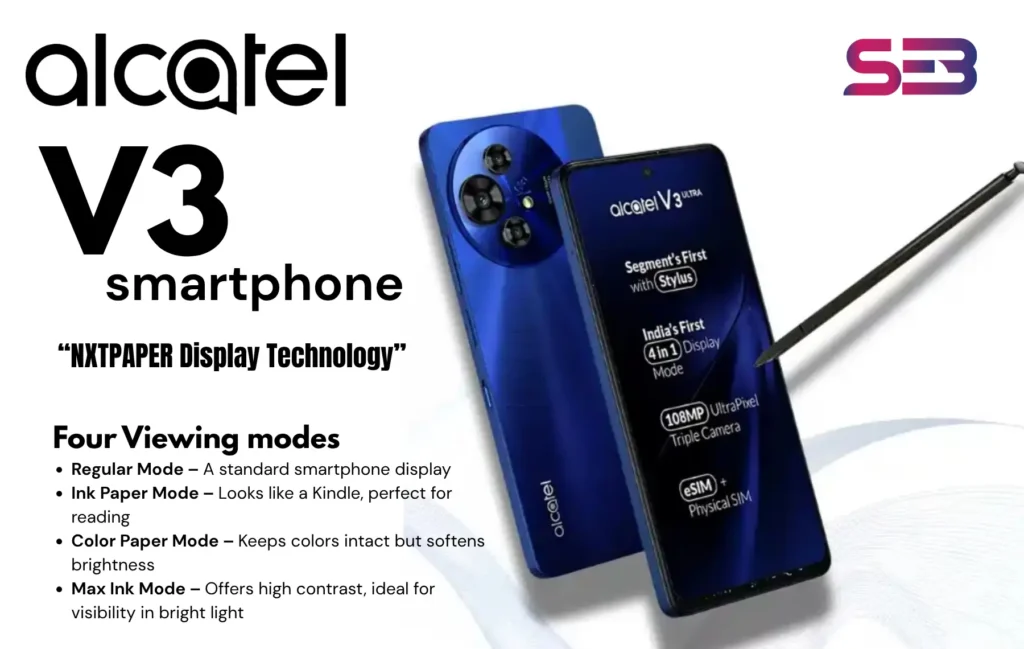Alcatel has made a big comeback in India with the launch of its new V3 smartphone series — V3 Ultra, V3 Pro, and V3 Classic. These phones bring a unique feature called NXTPAPER display technology, which gives a smooth, paper-like viewing experience. This makes the screen easier on the eyes, especially for people who spend a lot of time on their phones.

This launch is more than just a product release — it signals Alcatel’s re-entry into the Indian market, and their serious attempt to offer something different in a crowded mid-range smartphone segment. By introducing a special display experience at an affordable price point, the company is targeting young users, professionals, and students alike who need both screen comfort and performance.
What’s Special About the V3 Series?
The V3 phones run on the latest Android 15 and are powered by MediaTek processors, which are known for balancing performance and battery life well in budget and mid-range devices.
What makes these phones truly stand out is the NXTPAPER display technology. While most phones today are focused on high refresh rates or AMOLED displays, Alcatel has gone in a new direction — offering displays that mimic the look of real paper, reduce blue light, and cause less eye fatigue.
According to the details, the phones come with four viewing modes:
- Regular Mode – A standard smartphone display
- Ink Paper Mode – Looks like a Kindle, perfect for reading
- Color Paper Mode – Keeps colors intact but softens brightness
- Max Ink Mode – Offers high contrast, ideal for visibility in bright light
These modes are great for users who spend hours reading, browsing, or working on their phones. They help reduce digital eye strain — a growing concern in today’s always-online lifestyle.
The build quality of the V3 series is said to be premium for its price point, with a clean UI and essential features like fingerprint unlock, face unlock, and dual SIM support.
Price and Availability:
The V3 Ultra, Pro, and Classic is available for purchase starting June 2, 2025, and sold exclusively through Flipkart.
Pricing starts from ₹12,999, making it competitive with brands like Xiaomi, Realme, and Samsung’s M series. This price range is especially attractive for students, first-time smartphone buyers, and people looking to upgrade without spending a fortune.
Alcatel’s partnership with Flipkart is also a smart move, considering the platform’s deep reach in Tier II and III cities — where price-sensitive users are actively looking for value-packed devices.
IN Focus on Make in India:
Alcatel is not just launching phones — it’s making a serious investment in India’s tech and manufacturing ecosystem. As reported by Business Standard, the company plans to invest around $30 million (approx. ₹260 crore) in India to support its manufacturing and service operations.
The company plans to set up a local assembly line, helping reduce import costs and align with India’s growing ‘Make in India’ push. It will also develop service centers in major cities to ensure better after-sales support — something that’s often missing with new or re-entering brands.
This strategy not only improves brand trust but also boosts the local economy by generating employment opportunities. It’s a long-term play that could help Alcatel rebuild its brand image and customer base in India.
Leadership Behind the Move:
One of the most interesting aspects of this launch is the leadership driving it. The man behind Alcatel’s India comeback is Madhav Sheth, the former CEO of Realme India — a brand that grew rapidly under his guidance. Now working with Nxtcell, Sheth is overseeing the Alcatel project with a strong focus on innovation and user value.
This leadership adds credibility to Alcatel’s return. As mentioned in Gadgets360, Sheth shared that the company will prioritize not just features, but real user benefits like battery life, screen comfort, and software experience — areas that are sometimes overlooked in budget devices.
Having someone with Sheth’s background is a strong signal that Alcatel doesn’t want to just exist in the market — it wants to lead again.
How It Compares to the Competition:
In India’s budget and mid-range segment, competition is tough. Brands like Redmi, Realme, Motorola, and Samsung already offer strong alternatives with high-refresh displays, big batteries, and capable cameras.
However, where Alcatel is trying to stand out is with its NXTPAPER tech and clean user experience. While others focus on flashy specs, Alcatel is betting on something that directly solves user pain points like eye strain, screen fatigue, and usability over long hours.
If the performance matches the promise, this could create a new niche in the market — phones for students, readers, and professionals who prioritize eye comfort and long use over just camera specs or refresh rates.
What This Means for Indian Consumers:
For Indian users, the launch of the V3 series means more choices in the sub-₹15,000 segment. But more importantly, it also introduces a new kind of screen tech that wasn’t widely available before.
With mobile use increasing in study, work, and entertainment — comfortable displays matter more than ever. Alcatel is addressing that with NXTPAPER, and that’s something worth watching.
For those who use their phones to read PDFs, watch educational videos, or scroll endlessly on social media — this display might just be a better, healthier option.
Final Thoughts:
With features like NXTPAPER display, the latest Android 15, and competitive pricing, the Alcatel V3 series is looking like a strong comeback product. Backed by industry leadership, a focus on local manufacturing, and a clear positioning strategy, Alcatel is not just launching smartphones — it’s rebuilding its identity.
If the early user reviews turn out positive, the V3 series could be the first step in a fresh chapter for Alcatel in India.




